What is the best efficient FPV camera?
It is rather hard to enjoy all the beauty of a landscape without being high in the sky in the cockpit of a plane. But with a first-person view camera (FPV camera) this pleasure becomes closer. Just install the FPV camera on your radio-controlled vehicle and be ready to enjoy the greatest landscapes without being high above.
To help you to select the best FPV camera, we have prepared a review of seven decent options. We considered the advantages and disadvantages of each camera, as well as their features to make sure your flying experience will be on point.
When you decide to use the quadcopter or drone with a camera, the quality of the camera you choose becomes very important. It will influence the whole experience of flying and shooting videos or photos.
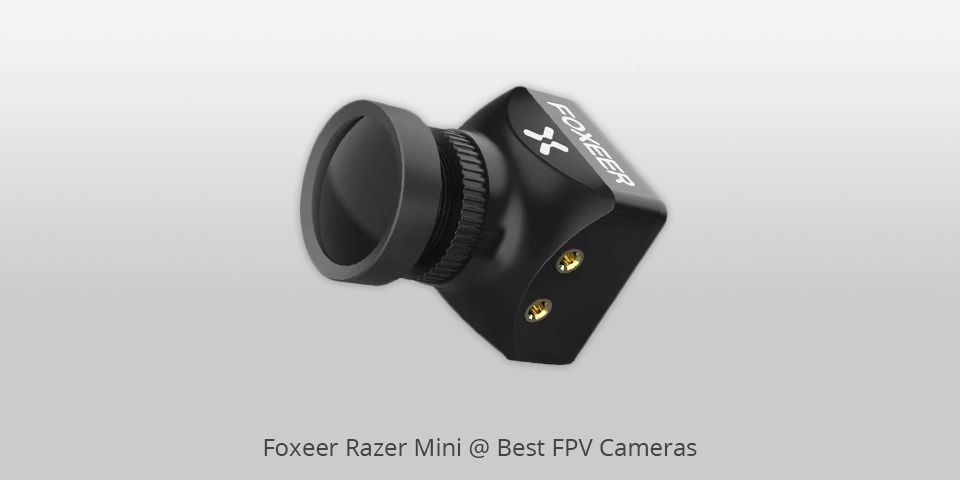
Sensor type: Sony 1/3" CMOS | Resolution: 1200TVL | Lens: 2.1 mm | Signal System: PAL/NTSC Switchable | Screen format: 4:3/16:9 Optional | Shutter Speed: PAL 1/25-1/10000 sec; NTSC 1/30-1/10000 sec
⊕ Wide dynamic range
⊕ Great features
⊕ Top-quality image sensor
⊕ Low latency
⊖ None found
Foxeer Razer Mini is the best FPV camera for racing drones. It is provided with 1200 TVL and a top-quality 2.1mm lens, which ensures great clarity and light handling both in daylight and in the dark.
Other attractive features of this camera are: low latency of 4ms, advanced Natural Image technology, HD 2.1 mm lens, 1/3” CMOS sensor, and multi-voltage. Considering its price, which is quite affordable, the Foxeer Razer Mini may be the best FPV camera for people with limited funds.
Thanks to the voltage range of 4,5V – 25 V, the camera is compatible with any pair of goggles. The aspect ratio may be adjusted between 4:3 and 16:9, so you are welcome to choose the option you like more.
If you are looking for a good FPV camera for your racing drone, or any other flying device, don’t hesitate to try the Foxeer Razer Mini, which is really value for money.
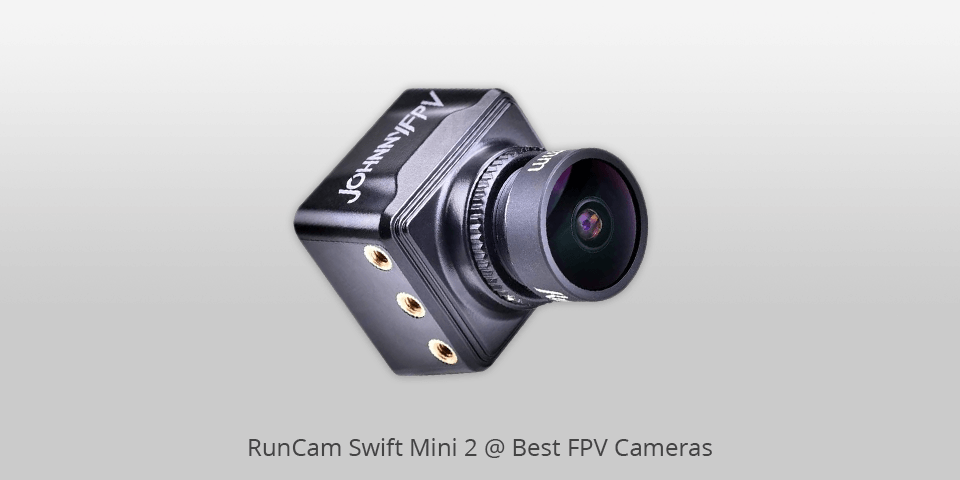
Sensor type: 1/3" SONY Super HAD II CCD | Resolution: 600TVL | Lens: 2.1mm (M12) FOV165° / 2.3mm (M12) FOV 150° | Signal System: PAL/NTSC Non Switchable | Screen format: 4:3 | Shutter Speed: PAL 1/50~100000; NTSC 1/60~100000
⊕ One-of-a-kind model
⊕ Easy setup
⊕ Built-in OSD
⊕ Wide viewing angle
⊖ Lacks a microphone
RunCam Swift Mini 2 is a good FPV camera with a built-in OSD. The Swift Mini 2 is very similar to the previous model, but this camera has an OSD and five preset image settings to get great images in daylight as well as when in the dark.
The camera is provided with 2.1mm (M12) of FOV165° and the top-quality 1/3"" SONY Super HAD II CCD sensor to ensure capturing the most beautiful landscapes.
The RunCam Swift Mini 2 has JohnnyFPV's own personal settings. The camera is supposed to fit 3” mini quad (150) market, or any other frame, requiring a small FPV camera.
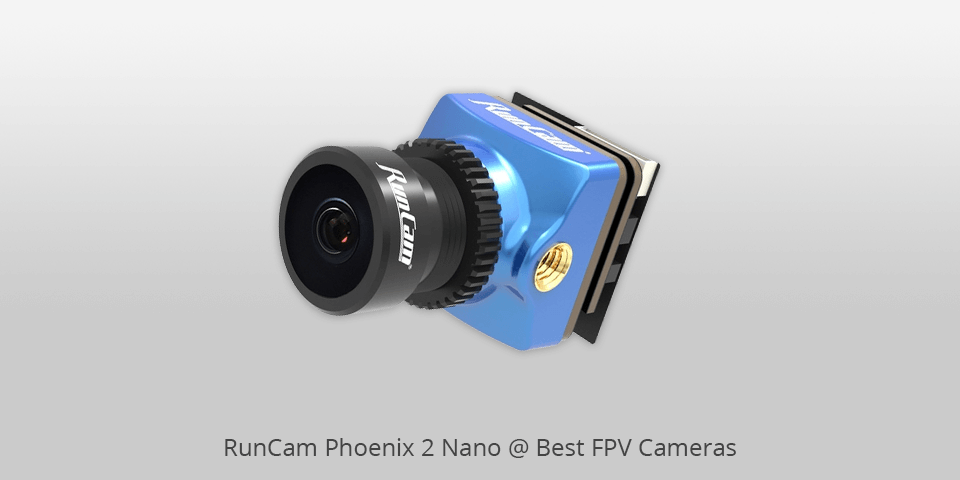
Sensor type: 1/2" COMS Sensor | Resolution: 1000TVL | Lens: 2.1mm (M8) FOV155° (4:3) | Signal System: PAL/NTSC Switchable | Screen format: 4:3/16:9 Switchable | Shutter Speed: no information
⊕ Top-quality lens
⊕ Great image sensor
⊕ Perfect performance
⊕ Less digital image shimmer
⊖ No built-in OSD
RunCam Phoenix 2 Nano may be considered the best FPV camera, as it is provided with the top-quality 1/2” image sensor, original M8 lens, and shows great performance both in daylight and in the dark. A high-performance image sensor guarantees a high-resolution picture with 4:3 or 16: aspect ratio.
The glass lens, used in the camera, has special layers, which make the image clearer, comparing to what other models provide. The RunCam Phoenix 2 Nano is a very good FPV camera, which offers great performance at a reasonable price.
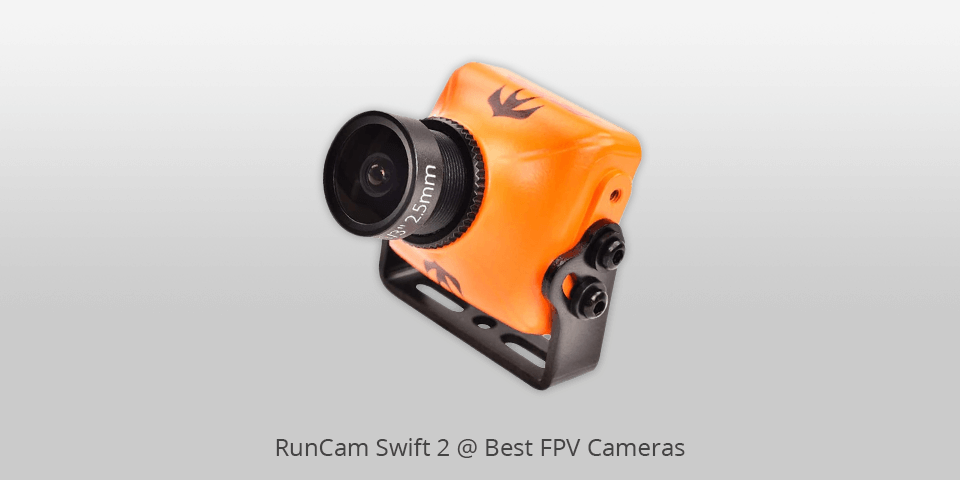
Sensor type: 1/3" SONY Super HAD II CCD | Resolution: 600TVL | Lens: 2.5mm | Signal System: PAL/NTSC Non Switchable | Screen format: 4:3 | Shutter Speed: PAL 1/50~100000; NTSC 1/60~100000
⊕ Reliable build quality
⊕ Built-in OSD
⊕ Integrated microphone
⊕ Wide voltage range
⊖ Not designed to use in low light
The RunCam Swift 2 is improved compared to its predecessors and supplied with new attractive features. It can show you the battery voltage on the screen.
The stated voltage may range from 5V to 36V, in fact, the range is even wider. The camera offers you a high-quality microphone for audio recording, which is located on the back to minimize the wind noise.
Besides, you may use a timer and put the pilot’s name. Considering this OSD features, the RunCam Swift 2 seems a very good FPV camera.
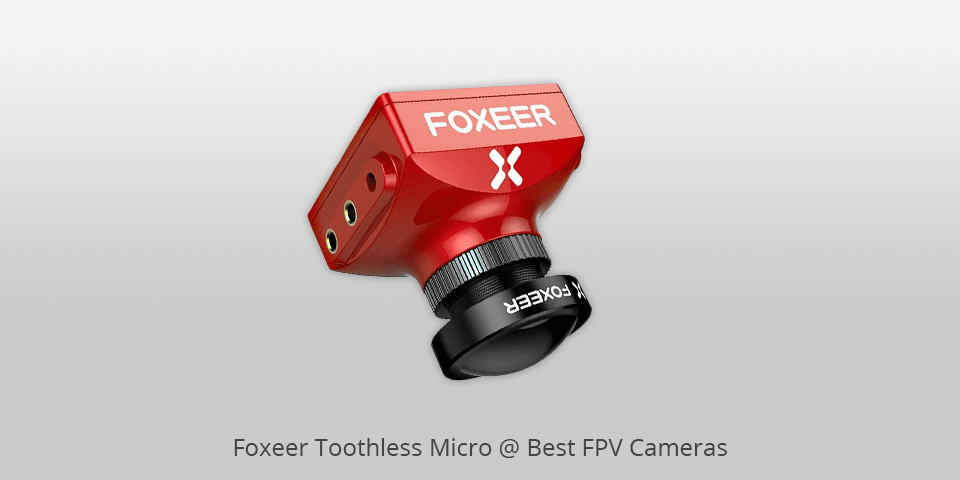
Sensor type: Sony 1/2" CMOS | Resolution: 1200TVL | Lens: 1.7mm | Signal System: PAL/NTSC Non Switchable | Screen format: 4:3/16:9 Switchable | Shutter Speed: PAL 1/25~1/10000 sec; NTSC 1/30~1/10000 sec
⊕ Wide viewing angles
⊕ Low latency
⊕ High definition OSD
⊕ Weighs next to nothing
⊖ Comes without a microphone
Foxeer Toothless Micro is the best mini FPV camera to use in all weather conditions. It is provided with an M12 1.7mm 5MP lens and ½” sensor for enhanced image quality.
The camera has OSD and it is possible to control the menu remotely. The aspect ratio may be switched between 4:3 and 16:9. You can also choose NTSC or PAL. This small FPV camera has an automatic white balance option and low latency to deliver top-quality images and improve your FPV experience.
Though the camera is small, it is provided with a very good matrix and the sensor, which is one of the best in its class. It ensures great shots and video even in low light conditions, as well as when the sun is bright.
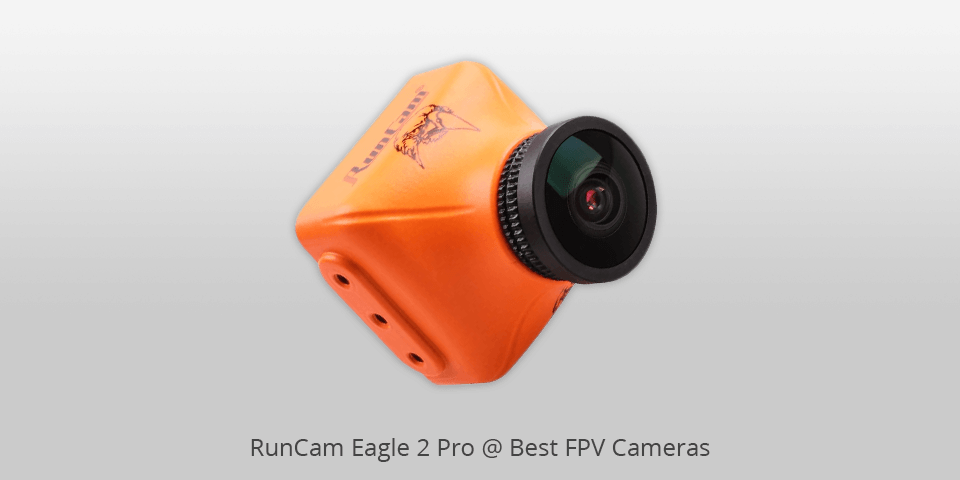
Sensor type: 1/1.8" CMOS Sensor | Resolution: 800TVL | Lens: 2.1mm FOV170° / 2.5mm FOV 140° | Signal System: NTSC / PAL Switchable on OSD menu | Screen format: 16:9/4:3 Switchable on OSD menu | Shutter Speed: no information
⊕ WDR CMOS sensor
⊕ Built-in microphone and OSD
⊕ Low latency
⊕ Great dynamic range
⊖ Some digital artifacts
RunCam Eagle 2 Pro is one of the most popular FPV cameras on the market. Perfect light handling and wonderful image quality make it the best camera for FPV flying.
The aspect ratio may be switched between 16:9 and 4:3, other great features include low latency and great visibility even in low light. The RunCam EAGLE 2 Pro comes with a 1/1.8 inch WDR CMOS sensor, integrated OSD, which can show the battery voltage, the name, and the time.
If you need to record audio, there is a built-in microphone. Considering all the attractive features of the camera, the RunCam EAGLE 2 Pro may be the best FPV camera in its category.
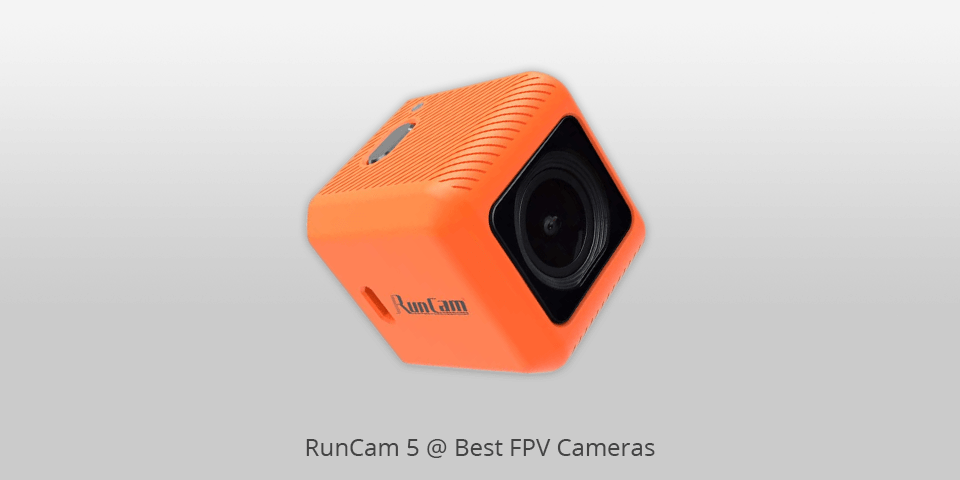
Sensor type: SONY IMX 377 (12MP) | Resolution: 1440P@60fps | Lens: no information | Signal System: NTSC / PAL Switchable | Screen format: 16:9/4:3 | Shutter Speed: Auto 1/30 1/60 1/120 1/240
⊕ Unique design
⊕ EIS chip
⊕ Top-quality image sensor
⊕ Ultra-low power consumption
⊖ TV-OUT cable is absent
⊖ High price
The RunCam 5 has an absolutely unique design in the shape of a cube. The top-quality image sensor (Sony IMX377) captures the video in 4K at 30 fps. Moreover, you may record at 120 fps if you switch to 1080p. The aspect ratio may be selected in the range from 4:3 to 16:9.
The RunCam 5 is made of extremely durable plastic, which protects the camera in case of an unexpected crash. The amount of ports and buttons is limited: the power button on the top, which is also used to start recording, and a LED light.
On the side, you will find a Micro USB port to charge the camera. It supports the TV-OUT function, though there is no TV-OUT cable. Don’t hesitate to try the RunCam 5 if you are looking for a good FPV camera and your budget is a bit limited.
| Image | Name | Features | |
|---|---|---|---|
 |
Foxeer Razer Mini
Our Choice |
CHECK PRICE → | |
 |
RunCam Swift Mini 2
For Racing Drone |
CHECK PRICE → | |
 |
RunCam Phoenix 2 Nano
For Quadcopter |
CHECK PRICE → |
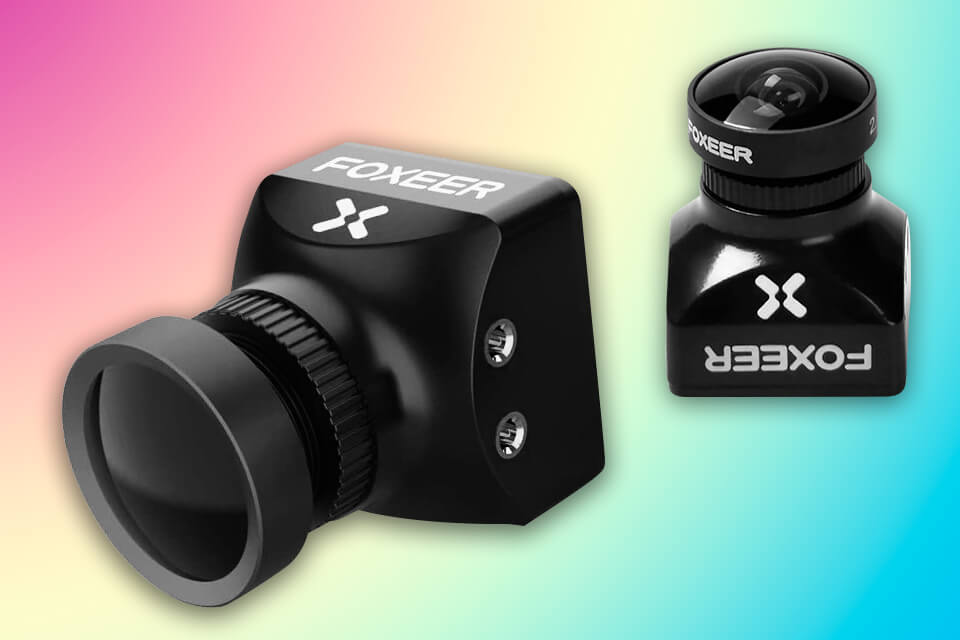
The most important thing to remember is that the best FPV camera records footage with low latency in real time. To get a reliable device, check such characteristics as camera size, aspect ratio, sensor (type and size), field of view, additional features.
The FPV cameras come in four sizes: Standard, Mini, Micro, and Nano. The mounting hole to attach a camera on the frame defines the size category of the FPV camera. Different drones require devices of different sizes. So, be sure to check that the FPV camera you choose is compatible with the drone you are going to use.
The FPV cameras with the mounting holes of 28mm are considered to be standard models. Apart from the larger frames, they are also compatible with some of the medium-sized frames. This standard was established in 2017 by the RunCam Swift, and is used now in RC airplane FPV.
Mini cameras come with a mounting hole of 21mm, and they fit medium-sized frames. The cameras of this size are very popular nowadays, and it is possible to convert them into FPV/HD cameras.
For an ultra-light racing drone, you are going to need a micro-sized FPV camera. The mounting hole will be 19mm. Though the cameras are small, it doesn’t influence their quality.
Such cameras are used on the quads, sized 2” or under. They are not provided with hard cases and don’t have any mounting options.
Aspect ratio means the shape of the image that the camera captures. You may choose between 16:9 FPV camera and 4:3, though a really good device will provide you with both options. A usual LCD TV and a computer monitor have the aspect ratio of 16:9. 4:3 is squarer, and is used in old CRT TV-sets. It doesn’t mean that one aspect ratio is better than the other. In fact, it doesn’t influence the image quality a lot, but remember to check, if the camera and the screen you are planning to use, have the same aspect ratio. The aspect ratio is your personal preference, but make sure your new device is compatible with the devices you already have, concerning the aspect ratio.
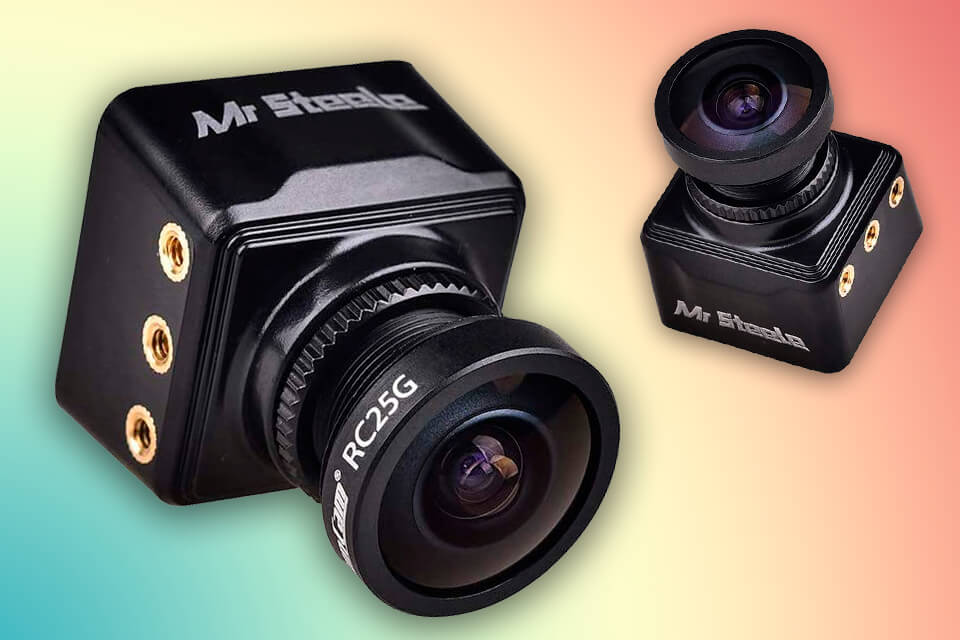
The FPV cameras come with two types of image sensors: CCD and AMOS. CCD has been widely-used on FPV cameras, as it ensures better and more solid performance. Nevertheless, the new CMOS technology is being improved and nowadays is used in most newest FPV cameras. The SMOS technology is developing, the sensors are being improved, while their price is decreasing. The sensor size is the characteristic that matters a lot. The larger the sensor, the better the performance in low light.
The field of view (FOV) of a good FPV camera depends on the focal length of the lens and the size of the sensor in the camera.
With short focal length, you will get wider FOV. The larger the focal length, the wider the FOV. The field of view of the camera is mainly your personal preference, though there are cases when it is important to consider the environment you are planning to fly in.
You won’t be able to see the object clearly enough with small FOV, as the image will be too zoomed. The wider FOV the camera has, the more details of the environment you will be able to see, and the better experience you will get.
Nevertheless, if the FOV is too large, the image may be distorted, and you will experience a so-called “fish-eye” effect. The image will be curved at the edges, and the details in the middle will look smaller and further than in reality. So, be careful, to choose the camera with the right FOV.
Nowadays the digital technologies are quickly evolving, so are the FPV cameras. Some manufacturers take advantage of the possibility to make their product unique and add some special additional features to the basic function set.
The OSD (on-screen display) now is a very popular additional feature, that many advanced FPV cameras have. If your drone FPV camera is provided with the on-screen display, it means that you will see the most important information, such as battery voltage, “ON” time, etc. This will help you use the drone flying with your camera more efficiently.
If the camera comes with a built-in microphone, you can record sound from the perspective of the quadcopter, though it will be mostly the sound of propellers. But, some people are pleased to hear the sound of the motor working, even when the device is far away.
Good light is extremely important even for a very good FPV camera. Although some cameras are designed to be successfully used in the dark. So, if you are going to use your FPV camera in the place, where there are little daylight hours, or other areas with low light, be sure to consider this fact, and choose the right camera.
After numerous tests and deep research, we came to the conclusion, that the Foxeer Razer Mini is the best FPV camera for quadcopter or racing drones.
FPV camera is a first-person view shooting device, in other words, it is video piloting. With an FPV camera, a quadcopter or a drone is controlled from the viewpoint of a pilot or a driver. It may be also called a remote-person view (RPV).
(TV lines) is used to measure analog FPV camera resolution. The number of alternating black and white lines displayed in the image horizontally is the TVL. A 600TVL camera can display 300 black lines and 300 white lines alternately in one frame.
The FPV camera has to be mounted onto a drone or a quadcopter, and it will transmit video in real time to another device. Another device may be a remote-control screen, or a monitor, or a smartphone, a tablet, or FPV goggles. A good FPV camera is light, small, and reasonably priced.

 Rating
Rating